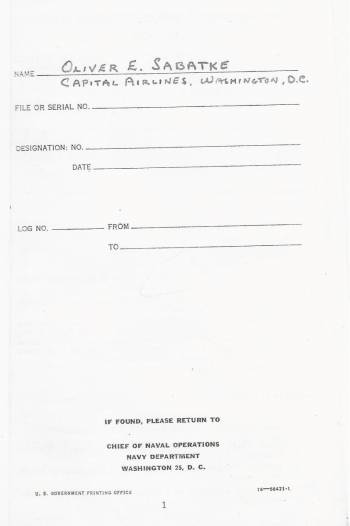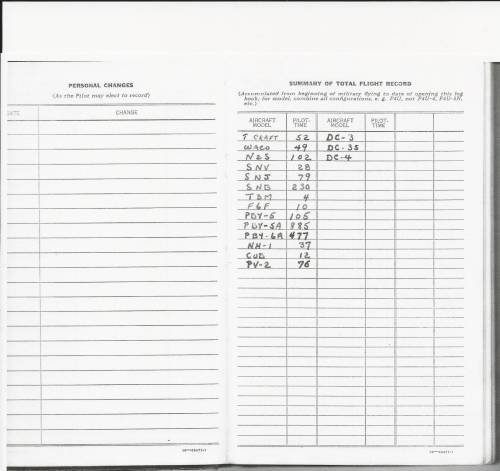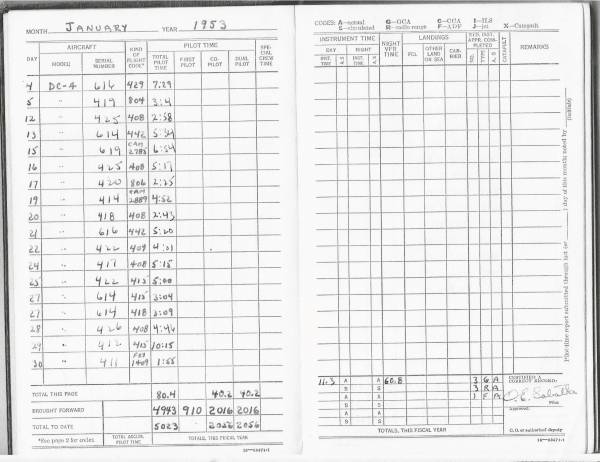Captain Sabatke's Log Book
Shortly before the July 9, 2014 memorial for United Flight 823, I received an email from Captain Oliver E. Sabatke's son, Todd Sabatke. We had been exchanging emails for only a few days. In this particular message he stated that his father, during World War II, flew PBYs.
For those who are not familiar with military aircraft from the WWII era, PBYs were amphibious aircraft capable of landing in and taking off from water. They were commonly known as “flying boats”. More will appear about PBYs later in this article.
There have been others, besides myself, who give plausibility to the idea that Captain Sabatke may have intended to land his stricken aircraft in Douglas Lake. More than two years ago, I based my original assumption on a United States Navy accident report that gave the circumstances and end result of a 1944 crash landing that Sabatke (then an Ensign in the U.S. Navy) was forced to make in the ocean near the Eniwetok Atoll, which was a U.S. naval base of operations in the Marshall Islands.
To hear Todd Sabatke's words that his father was a PBY pilot has given me reason to explore, even further, his fathers possible intention of landing United Airlines Flight 823 in Douglas Lake.
While corresponding with Todd at that particular time, I had no idea that he had in his possession boxes of papers and records that belonged to his father. He mentioned a log book that was among his father's belongings. When I questioned Todd about the log book, he told me that he would have to look through it when he arrived back in Colorado-after his family trip to Tennessee for the United Flight 823 memorial.
Soon after his return home to Colorado, Todd sent me scans of several pages from the log book that provide information I believe can give more credence to my theory. Among the pages I received is an inside cover with Oliver E. Sabatke's name neatly printed in block letters along with “Capital Airlines, Washington, D.C. ”
The next page (Above Right) is a summary of total hours Ensign Sabatke had flown in fourteen different military aircraft. Some of these hours were flown during training and there were some that had to have been flown during combat missions-most notably those flown in three different types of PBYs.
Another page (Below Right) was one that was compiled in January 1953; in which Captain Sabatke logged his time flying DC4 aircraft. In the bottom right hand corner is a very legible signature certifying that Sabatke was the pilot of record.
It should be noted that the log book is actually one that had been issued by the Navy Department. Each page I have posted is identified by the same number on the bottom right: 16–68471-1.
The reader may question why any of this matters. The answer, in my opinion, is that, if Douglas Lake was the pilot's possible objective of last resort, then it may explain the reason for the “deviation” the plane took 8 miles south of the V16 centerline, as noted on Page 13 of the Civil Aeronautics Board Aircraft Accident Report.
Looking at the Tennessee Aeronautics Chart, it can be established that a line drawn from Bird's Bridge to the Knoxville VORTAC, not only runs “roughly parallel” to V16 as the CAB Report mentions; the line, if Flight 823 had continued, would have eventually taken the aircraft back within the V16 airway. It should also be made known that Victor Airways are 8 miles wide-with four miles of width on either side of the centerline. So, in reality, the aircraft Sabatke was piloting was 4 miles off of V16 airway's southern boundary. The discrepancy would have been more pronounced had Flight 823 been flying Instrument Flight Rules (IFR), but we know, from reading the CAB report that Captain Sabatke had requested and received clearance to continue the remainder of the approach to Knoxville under Visual Flight Rules (VFR).
Why was the aircraft four miles to the south of the airway? Could it have been that the Captain, once he saw that the airplane was in trouble, wanted to avoid other air traffic that was possibly within the V16 corridor?
The accident report that dealt with his F6F-3 crash landing in the sea off of Eniwetok, November 30, 1944, mentions his decision to avoid boat traffic in the harbor. Subsequent research reveals that the airstrip on Eniwetok Atoll was extremely crowded with aircraft of all types. In fact, on August 9, 1944 a U.S. Navy bomber, while attempting a take off, crashed and destroyed “no less than 106 Navy Planes” on the Eniwetok airstrip. http://aviation-safety.net/wikibase/wiki.php?id=74133
It is not clear, at present, whether or not Oliver Sabatke, was stationed on Eniwetok at that juncture, but this writer is confident that the events of August 9, 1944 were still fresh in the minds of those stationed there and were most likely a subject of daily “lessons learned”.
In my opinion, Captain Sabatke's initial reaction on July 9, 1964, twenty years after his time spent on Eniwetok Atoll - especially after his Vickers Viscount lost communication with the ground - would have been to get out of the way of other aircraft that may have been in the area. That would mean “deviating” from the V16 airway. By taking the path he decided to take, he would still maintain line of sight with Knoxville; while the possibility remained of landing the plane in Douglas Lake which lay a few minutes ahead in the distance.
Pilots who flew Consolidated PBY Catalinas in World War II had no gauges in front of them, because they would serve as a distraction to pilots whose main duty was to look out the plane's windows. The first flight engineers served on board PBYs. The job of the flight engineer was to read all the gauges, control the engines, and do whatever duties were non essential to actually flying the airplane. *
PBYs were the first long range patrol aircraft, thus it was necessary for the eyes of the pilots to be searching outside the aircraft for enemy shipping, enemy submarines and downed Allied pilots in need of rescue. Pilots were accustomed to what would be referred to today and in 1964 as “Visual Flight Rules”.
Pilots of PBYs often had to land and take off in 10-foot seas in order to rescue downed Allied pilots.
There were no wing flaps on PBYs. PBY pilots often flew at low altitudes. Mine laying operations in the Pacific Theater required that pilots of PBYs maintain altitudes of 200 feet above the water in order to safely lay mines in harbors that contained enemy shipping. In order to avoid detection by Japanese Zero aircraft, these dangerous, low level flights had to be conducted at night.
Low level flights also were a necessity in attacking enemy submarines and in rescuing Allied pilots.
It is not yet definitively known whether Captain Sabatke took part in mine laying operations, known as “Cat” missions or if he took part in sea landing rescues of downed pilots, known as “Dumbo” operations. In my mind there is a certainty that he, at the very least, trained for these types of missions and would have attained a good grasp of flying PBY aircraft at low altitudes and would have had the capability to successfully land a Vickers Viscount in Douglas Lake.
I conclude by asking that the reader make note of the log book I have illustrated above that, while serving in the United States Navy during World War II, the 1,467 hours logged in PBYs by Oliver Sabatke were, by far, more hours than he logged in any other type of military aircraft.
* Source: Jim Slattery



